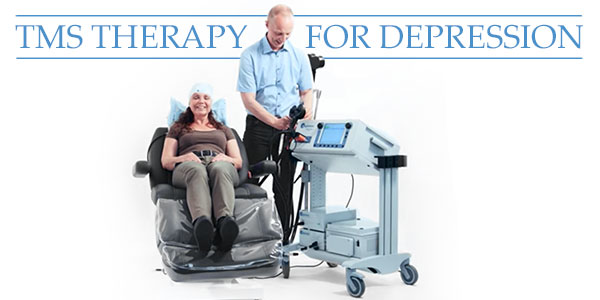How Single Parents Can Manage Mental Health and Thrive Well
Key Takeaways: You are not alone — 25.1% of American children live in single-parent homes. Proven treatments like home therapy and support groups…

Transcranial magnetic stimulation (TMS) – A new hope for treating depression when other treatments have failed or were only partially effective, it is FDA-cleared, non-invasive, and covered by most insurances.
Even though it was mentioned in the 19th century by, In the modern era, it was introduced in 1985, transcranial magnetic stimulation (TMS) is a non-invasive brain stimulation therapy without surgery or nesthesia that helps treat psychiatric disorders like major depression.
We localize areas in the brain(Mapping) and then use high-power magnets that generate magnetic fields to stimulate targeted areas of the brain to alleviate depression. it is also being researched for other brain conditions that show some potentially beneficial results. it is currently FDA-cleared for depression, OCD, and smoking cessation.
According to the National Center for Biotechnology Information, 30-40% of patients experiencing depression don’t respond to traditional treatments like medication and talk therapy. If you have been diagnosed with depression, and your symptoms have not improved through these traditional methods, you may be a good candidate for this non-invasive brain stimulation therapy with minimum risks and side effects.
After the consultation and if it’s been decided that you are a good candidate, treatment begins:
Step 1: You will sit in a reclining chair with a footrest. The clinician and technician will keep a pillow around your head to make you feel comfortable.
Step 2: You will wear a cotton cap with a mark on the treatment area that is assessed during the Brain Mapping.
Step 3: A certified clinician/technician will secure the electromagnetic coil against your scalp.
Step 4: The electromagnetic coil will stimulate specific nerve cells in your brain, which control mood and depression.
Step 5: The magnetic pulses activate parts of the brain that have decreased activity due to depression and rejuvenate connectivity among the neurons.
Step 6: The stimulation helps to reduce your depression symptoms and can result in”Remission”( full recovery from the episode) or a “Response”( at least 50% Improvement).
An experienced Board Certified Psychiatrist supervises all of the steps with vast familiarity with TMS.
You can visit the mental health clinic and go back home alone. However, we welcome guests if you choose to.
TMS therapy is non-invasive. We don’t use anesthetics or sedation.
Traditional TMS therapy: This is the primary form of TMS therapy given to patients with Major Depressive Disorder. Traditional TMS therapy uses low-intensity magnetic pulses to stimulate brain nerve cells that control mood.
Deep transcranial magnetic stimulation (dTMS): dTMS involves a non-invasive brain stimulation technique. The magnetic stimulation is delivered to the deep brain areas.
In deep TMS therapy, physicians use different H-coils to stimulate up to 4cm beneath the skull.
Repetitive transcranial magnetic stimulation (rTMS): During an rTMS treatment session, the patient receives a series of brief, repeated, and highly focused magnetic pulses called a pulsed magnetic field. These pulses stimulate brain cells in treating MDD.
The treatment session lasts for about 19 to 37 minutes while patients recline in a comfortable chair. The patient remains awake and aware during all TMS treatment sessions. There is no medication necessary during treatment, and the patient generally experiences minimal side effects. The patient could relax, listen to music, or see videotapes during the treatment.
The treatment usually consists of five sessions per week for 5-6 weeks. Most patients will experience a lift in symptoms around the tenth session after two weeks of rTMS.After that, we may taper down to 2 times/week for another 3 weeks.The total average treatment is 36 sessions.
Intermittent Theta Burst Stimulation (iTBS): iTBS is an express 3-minute and 9 seconds session. iTBS uses a unique, higher frequency magnetic pulse that enables faster delivery of magnetic stimulation therapy.
iTBS, the accelerated form of TMS, consists of:
(Variable protocols can be developed on an individually tailored basis.)One example is:
TMS therapy is not only an effective treatment for depression, but it can also treat a variety of other mental health disorders.
Generalized anxiety disorder: TMS therapy can treat generalized anxiety when medication and psychotherapy don’t achieve positive results. It helps to reduce anxiety symptoms by controlling nerve cell activity in the prefrontal cortex.
Obsessive-Compulsive Disorder (OCD): According to the National Center for Biotechnology Information, individuals with OCD often have hyperactivity between the striatum and prefrontal cortex. TMS treatments can reduce the hyperactivity and OCD symptoms. This is already FDA-cleared.
Schizophrenia: Schizophrenic patients often have auditory hallucinations. Magnetic impulses are delivered to the overactive temporoparietal cortex, which is involved in language. This may help to reduce auditory hallucinations.( this is considered experimental and not FDA-cleared yet)
Alzheimer’s disease: According to the National Center for Biotechnology Information, TMS therapy may help to reduce Alzheimer’s symptoms by changing the neural connections between memory and learning. (not FDA cleared but may be helpful based on experience in the very early stages of what’s called MCI)
Post-traumatic stress disorder (PTSD): TMS therapy is quite effective for PTSD. It helps to stimulate the prefrontal cortex and reduce fear and panic. ( it is not FDA-cleared yet)
Stroke rehabilitation: The magnetic impulses on the motor cortex help to promote motor recovery after a stroke. The motor cortex regulates voluntary movement. ( experimental, not FDA approved, but may be beneficial)
Nicotine addiction: TMS therapy stimulates the prefrontal cortex. It also helps to trigger the release of dopamine, lowering nicotine cravings. ( this is FDA-approved with a specific magnet and protocol)
Severe pain: TMS therapy stimulates the motor cortex and neurotransmitters involved in pain. This can give you relief from chronic pain. ( not FDA approved different Protocols are used with some success)
Multiple sclerosis: TMS treatment, along with physical therapy, can help to reduce spasticity. The stimulation helps to reduce muscle tightness and promotes body movement. ( not FDA approved but anecdotally noticed to be very beneficial)
Side effects of Medication and Electroconvulsive therapy are much more common and disturbing, including cognitive side effects, weight gain, sexual adverse events, Sleep disturbances, gastrointestinal side effects, etc…
By comparison, the side effects of TMS therapy are minimal and mild.
Clinical studies on long-term exposure to TMS therapy have not found any evidence of brain tumors in patients as a result of the therapy. It also does not cause memory loss or a reduction in concentration, or any other CNS side effects.
Failure (or side effects) of antidepressants: FDA recommends TMS for patients who did not experience positive results or had no response to 1-2 adequate antidepressant trials.
Most insurances such as Aetna, Cigna, Medicare, and Tricare require a trial of two antidepressants and psychotherapy (ex: 12 sessions of Cognitive Behavioral Therapy (CBT) for MDD).
Age: You should be at least 18 years old for insurance coverage.
Experience shows success with teenagers with TRD(off-label)
| What to consider | ECT | Medication | TMS | Conclusion |
|---|---|---|---|---|
| Do you need to get hospitalized? | Yes sometimes | No | No | TMS therapy is better than medication and ECT |
| Are there any significant side effects? | Yes | Yes | No | |
| Is it non-invasive? | No | Yes | Yes | |
| Is it painful? | Not much (done under anesthesia) | No | No | |
| Is it FDA-approved? | Yes | Yes | Yes | |
| Is it effective? | Response – 66 to 79%, Remission – 47 to 75% | Response – 49 to 52%, Remission – 28% | Response – 68 to 70%, Remission – 45% | |
| Do you need sedation? | Yes | No | No |
The cost of TMS therapy depends on several factors. To get an idea of the overall cost,fairhealthconsumer.orgis a great place to start.
The FDA approved TMS therapy to treat patients in 2008. Health insurance plans provide coverage for TMS therapy, as well. This will help to ease some of the financial burdens of your treatments.
Medicare covers TMS treatments only when talk therapy and medication have not helped to reduce your depression and anxiety symptoms.
The average success rate of TMS therapy is between 58% to 67%. The success rate of our psychiatrists is 80 -90 %.
TMS therapy is safe. However, you should avoid it if you have stents, metal plates, metallic facial tattoos, and metallic coils in your body due to the strong magnetic fields released during rTMS.
| MagVenture | Brainsway | Neurostar | Magstim | CloudTMS | |
|---|---|---|---|---|---|
| rTMS | Yes | Yes | Yes | Yes | Yes |
| iTBS | Yes | Not FDA approved | Yes | Yes | Not FDA approved |
| OCD | D-B80 | H7 | No | No | No |
No. In fact, studies have found TMS to be effective against treatment-resistant depression. Harvard Health also states that about 50% to 60% of people with depression experience a clinically meaningful response to TMS.
The effects of brain stimulation done by TMS can last six months to one year, sometimes longer. If needed, you should follow up TMS treatment with talk therapy or medication to maintain its effects.
TMS is a promising treatment for anxiety conditions and other disorders, like Obsessive-Compulsive Disorder and Post Traumatic Stress Disorder. Studies also suggest that TMS can effectively treat GAD (Generalized Anxiety Disorder). There are studies in addiction, smoking cessation, Pain conditions, Fibromyalgia, Multiple Sclerosis, Parkinsonian tremors, Tinnitus, MCI(Minimal cognitive impairment), and other conditions to come.
Not usually.
Most patients undergo TMS treatment with minimal side effects like skin tingling, mild headaches, and lightheadedness.
However, occasionally some patients may experience a temporary worsening of their mental disorder symptoms. This is known as TMS “dip,” which may occur about halfway through your treatment.
But it’s important to remember that it’s just a temporary effect.
TMS is a non-invasive procedure and does not require anesthesia. During the treatment, patients may feel a tapping or knocking sensation on their heads where the magnetic coil is placed. There are ways to minimize that.
Some patients may experience mild discomfort at the treatment site or mild headaches during the first week of treatment. These side effects usually dissipate within one to two weeks.
Typically, TMS therapy doesn’t cause tiredness or fatigue. On the contrary, many patients report feeling more energized and alert after TMS treatment. However, a few patients may experience fatigue, but that’s temporary. The side effects tend to fade within the first week of treatment.

Shebna N Osanmoh is a board-certified Psychiatric Mental Health Nurse Practitioner with extensive experience across the mental health spectrum. Holding a Master’s in Psychiatric/Mental Health Nursing from Walden University, Shebna provides compassionate, culturally sensitive care for a wide range of mental health conditions, emphasizing holistic and individualized treatment approaches to support patients in their wellness journey.
Key Takeaways: You are not alone — 25.1% of American children live in single-parent homes. Proven treatments like home therapy and support groups…
Money problems and mental health issues often go hand in hand. If you're asking "How can I get help without spending money?" you're not alone. Many…
The Silicon Valley executive arrives at work by 6 AM, leads three back-to-back meetings, codes for six hours straight and then stays late to "perfect" a…
"You are what you eat," is a saying that holds a lot of truth, especially when it comes to matters like brain health. What we consume directly or indirectly impa…